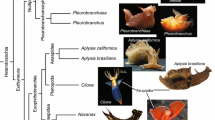Summary
-
1.
Sand crabs of the genus Emerita swim by rapidly beating their uropods. The morphology and physiology of the uropod muscles and their innervation in E. analoga have been described. A total of 11 muscles, 7 axial and 4 in the protopodite, under the command of about 50 motoneurons, control the cyclical beating of the uropods.
-
2.
Of the 7 axial muscles, 2 lie within the 6th abdominal segment and 5 occupy the telson. Two of the latter, the power-stroke muscle and the return-stroke muscle, perform the basic cycle of movement of the uropod; both are simply innervated (1 excitor, 1 inhibitor; 2 excitors, 1 inhibitor). The power-stroke muscle is unusual in that it shows small, facilitating excitatory junctional potentials rather than the large muscle potentials more commonly found in phasic crustacean muscles.
-
3.
Peripheral inhibition in the power muscles is post-synaptic and of long duration (∼1 sec). Its effectiveness varies considerably between individuals, and the behavioral role of the inhibition is not clear.
-
4.
The group of uropod muscles considered as a whole shows a range of physiological characteristics which distinguishes them from decapod limb muscles, on the one hand, and abdominal muscles, on the other. They show a broad range of properties and, except for the two power muscles, rich innervation.
Similar content being viewed by others
References
Atwood, H.L.: Crustacean neuromuscular mechanisms. Amer. Zool. 7, 527–551 (1967).
—, Dorai Raj, B.S.: Tension development and membrane responses in phasic and tonic muscle fibers of a crab. J. cell. comp. Physiol. 64, 55–72 (1964).
—, Hoyle, G., Smyth, T.: Mechanical and electrical responses of single innervated crab-muscle fibers. J. Physiol. (Lond.) 180, 449–482 (1965).
Bittner, G.D.: Differentiation of nerve terminals in crayfish opener muscle and its functional significance. J. gen. Physiol. 51, 731–758 (1968).
Davis, W.J.: Lobster righting responses and their neural control. Proc. roy. Soc. B 170, 435–456 (1968a).
- The neuromuscular basis of lobster swimmeret beating. J. exp. Zool. 168, 363–378.
Dorai Raj, B.S.: Diversity of crab muscle fibers innervated by a single motor axon. J. cell. comp. Physiol. 64, 41–54 (1964).
Dudel, J., Kuffler, S.W.: Presynaptic inhibition at the crayfish neuromuscular junction. J. Physiol. (Lond.) 155, 543–562 (1961).
Gillary, H.L., Kennedy, D.: Neuromuscular effects of impulse pattern in a crustacean motoneuron. J. Neurophysiol. 32, 607–612 (1969).
Jones, R. McC:. McClung's Handbook of microscopical techniques. New York: Hafner Publ. Co. 1950.
Kennedy, D.: The reflex control of muscle. In: Invertebrate nervous systems, their significance for neurophysiology ed. C.A.G. Wiersma, p. 197–212. Chicago, Illinois: Univ. of Chicago Press 1967.
—, Takeda, K.: The reflex control of abdominal flexor muscles. I. The twitch system. J. exp. Biol. 43, 211–227 (1965a).
— The reflex control of abdominal flexor muscles. II. The tonic system. J. exp. Biol. 43, 229–246 (1965b).
Lang, F., Sutterlin, A., Prosser, C.L.: Electrical and mechanical properties of the closer muscle of the Alaskan king crab, Paralithodes camtschatics. Comp. Biochem. Physiol. 32, 615–628 (1970).
Larimer, J.L., Kennedy, D.: Innervation pattern of fast and slow muscles in the uropods of crayfish. J. exp. Biol. 51, 119–133 (1969).
Paul, D. H.: Swimming behavior of the sand crab, Emerita analoga (Crustacea, Anomura): a neurophysiological analysis. Ph.D. Thesis, Stanford University (1970).
—: Swimming behavior of the sand crab, Emerita analoga (Crustacea, Anomura). I. Analysis of the uropod stroke. Z. vergl. Physiol. 75, 233–258 (1971a).
—: Swimming behavior of the sand crab, Emerita analoga (Crustacea, Anomura). III. Neuronal organization of uropod beating. Z. vergl. Physiol. 75, 286–302 (1971b).
- In preparation (1971 c).
Author information
Authors and Affiliations
Additional information
This work was supported in part by a predoctoral fellowship to the author from the National Institutes of Health (GM-33835) and by a grant (NB-02944) from the National Institutes of Health to Dr. D. Kennedy.
I thank Dr. Donald Kennedy for his interest and advice throughout the course of this work.
Rights and permissions
About this article
Cite this article
Paul, D.H. Swimming behavior of the sand crab, Emerita analoga (Crustacea, Anomura). Z. vergl. Physiologie 75, 259–285 (1971). https://doi.org/10.1007/BF00340681
Received:
Issue Date:
DOI: https://doi.org/10.1007/BF00340681




